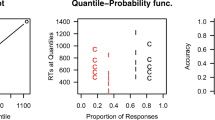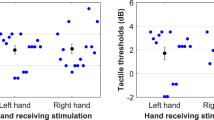Abstract
Research suggests that vision of the body-part that happens to receive a tactile event enhances the processing of this stimulus. However, it would appear that only tactile distractors delivered to visible body-parts are processed up to the level of response selection. Here, we analyze whether vision or higher order cognitive processes influence the processing of tactile distractors. We compared the processing of distractors in a tactile variant of the Eriksen flanker task when the body-parts receiving target and distractor stimuli were separated by different types of barriers. Surprisingly, an impermeable barrier prevented tactile distractors from being processed up to the response level, irrespective of whether the barrier was transparent or opaque. By contrast, when an empty frame was placed between the participant’s hands, distractors were processed up to the level of response selection. Hence, higher order cognition (here the visually induced representation of the target-distractor separation) influences the processing of tactile distractors. We discuss these results in the light of related findings from selective reaching experiments as well as in terms of Gestalt grouping.




Similar content being viewed by others
Notes
One may wonder why occluder type did not modulate the average performance (irrespective of the flanker effects); i.e., it could be argued that target processing per se should be influenced by the occluder type, perhaps the strongest in the condition with a centrally presented target hand. We therefore selectively compared the mean accuracy between the opaque-occluder and no-occluder conditions only for target central trials – in which the direction of gaze as well as the occlusion of the distractor from view might be expected to facilitate target processing. However, still no significant influence of the occluder was observed, t <1 (t <1, also for mean RTs). We replicated this result in a control experiment (n =36) contrasting a no-occluder condition to a condition in which the distractor hand was positioned 40 cm apart from the body midline under an occluder box, and was additionally separated from the target by means of an opaque shield positioned between the hands. Still, the opaque and no-occluder conditions of the control experiment did not differ with regard to the mean accuracy or the mean reaction times, both ts <1. We therefore suggest that these null-effects of the occluder manipulation on the overall performance are likely attributable to the complex stimulus materials and the resulting quite long response times (on average >1900 ms).
Interestingly, the introduction of a transparent barrier revealed no different effects on visuotactile interactions as compared to a condition without a barrier in the crossmodal congruency task (e.g., Kitagawa & Spence, 2005; see also Farnè, Demattè, & Làdavas, 2003). In a nutshell, one may conclude that congruency across modalities is differently affected by higher-order cognition than selection within a modality.
References
Allport, D. A. (1987). Selection-for-action: Some behavioral and neurophysiological considerations of attention and action. In H. Heuer & A. F. Sanders (Eds.), Perspectives on perception and action (pp. 395–419). Hillsdale, NJ: Erlbaum.
Baayen, R. H., Davidson, D. J., & Bates, D. M. (2008). Mixed-effects modeling with crossed random effects for subjects and items. Journal of Memory and Language, 59, 390–412.
Bates, D., Maechler, M., Bolker, B., & Walker, S. (2013). lme4: Linear mixed-effects models using Eigen and S4. R package version 1.0-5. http://CRAN.R-project.org/package=lme4
Botvinick, M., & Cohen, J. (1998). Rubber hands “feel” touch that eyes see. Nature, 391, 756. doi:10.1038/35784
Bregman, A. S. (1990). Auditory scene analysis: The perceptual organization of sound. Cambridge, MA: MIT Press.
Cardini, F., Longo, M. R., Driver, J., & Haggard, P. (2012). Rapid enhancement of touch from non-informative vision of the hand. Neuropsychologia, 50, 1954–1960. doi:10.1016/j.neuropsychologia.2012.04.020
Craig, J. C. (1974). Vibrotactile difference thresholds for intensity and the effect of a masking stimulus. Perception & Psychophysics, 15, 123–127. doi:10.3758/bf03205839
Craig, J. C. (1995). Vibrotactile masking: The role of response competition. Perception & Psychophysics, 57, 1190–1200. doi:10.3758/bf03208375
Dixon, P. (2008). Models of accuracy in repeated-measures designs. Journal of Memory and Language, 59, 447–456.
Driver, J., & Baylis, G. C. (1989). Movement and visual attention: The spotlight metaphor breaks down. Journal of Experimental Psychology: Human Perception and Performance, 15, 448–456. doi:10.1037/0096-1523.15.3.448
Driver, J., & Grossenbacher, P. G. (1996). Multimodal spatial constraints on tactile selective attention. In T. Innui & J. I. McClelland (Eds.), Attention and performance XVI: Information integration in perception and communication (pp. 209–235). Cambridge, MA: MIT Press.
Eriksen, B. A., & Eriksen, C. W. (1974). Effects of noise letters upon the identification of a target letter in a nonsearch task. Perception & Psychophysics, 16, 143–149. doi:10.3758/bf03203267
Evans, P. M., & Craig, J. C. (1992). Response competition: A major source of interference in a tactile identification task. Perception & Psychophysics, 51, 199–206. doi:10.3758/bf03212244
Farnè, A., Demattè, M. L., & Làdavas, E. (2003). Beyond the window: Multisensory representation of peripersonal space across a transparent barrier. International Journal of Psychophysiology, 50, 51–61. doi:10.1016/S0167-8760(03)00124-7
Frings, C., & Spence, C. (2010). Crossmodal congruency effects based on stimulus identity. Brain Research, 1354, 113–122. doi:10.1016/j.brainres.2010.07.058
Frings, C., & Spence, C. (2011). Increased perceptual and conceptual processing difficulty makes the immeasurable measurable: Negative priming in the absence of probe distractors. Journal of Experimental Psychology: Human Perception and Performance, 37, 72–84. doi:10.1037/a0020673
Frings, C., & Spence, C. (2013). Gestalt grouping effects on tactile information processing: When touching hands override spatial proximity. Attention, Perception, & Psychophysics, 75, 468–480. doi:10.3758/s13414-012-0417-6
Gallace, A., & Spence, C. (2005). Visual capture of apparent limb position influences tactile temporal order judgments. Neuroscience Letters, 379, 63–68. doi:10.1016/j.neulet.2004.12.052
Gallace, A., & Spence, C. (2011). To what extent do Gestalt grouping principles influence tactile perception? Psychological Bulletin, 137, 538–561. doi:10.1037/a0022335
Gallace, A., & Spence, C. (2014). In touch with the future: The sense of touch from cognitive neuroscience to virtual reality. Oxford, UK: Oxford University Press.
Gibson, J. J. (1979). The ecological approach to visual perception. Boston: Houghton Mifflin.
Jaeger, T. F. (2008). Categorical data analysis: Away from ANOVAs (transformation or not) and towards Logit Mixed Models. Journal of Memory and Language, 59, 434–446.
Kennett, S., Taylor-Clarke, M., & Haggard, P. (2001). Noninformative vision improves the spatial resolution of touch in humans. Current Biology, 11, 1188–1191. doi:10.1016/S0960-9822(01)00327-X
Kitagawa, N., & Spence, C. (2005). Investigating the effect of a transparent barrier on the crossmodal congruency effect. Experimental Brain Research, 161, 62–71. doi:10.1007/s00221-004-2046-3
Lamers, M. J. M., & Roelofs, A. (2007). Role of Gestalt grouping in selective attention: Evidence from the Stroop task. Perception & Psychophysics, 69, 1305–1314. doi:10.3758/BF03192947
Meegan, D. V., & Tipper, S. P. (1999). Visual search and target-directed action. Journal of Experimental Psychology: Human Perception and Performance, 25, 1347–1362. doi:10.1037/0096-1523.25.5.1347
Overvliet, K. E., Krampe, R. T., & Wagemans, J. (2012). Perceptual grouping in haptic search: The influence of proximity, similarity, and good continuation. Journal of Experimental Psychology: Human Perception and Performance, 38, 817–821.
R Core Team (2013). R: A language and environment for statistical computing. R Foundation for Statistical Computing, Vienna, Austria. URL http://www.R-project.org/
Spence, C., & Gallace, A. (2007). Recent developments in the study of tactile attention. Canadian Journal of Experimental Psychology, 61, 196–207. doi:10.1037/cjep2007021
Tipper, S. P., Lloyd, D., Shorland, B., Dancer, C., Howard, L. A., & McGlone, F. (1998). Vision influences tactile perception without proprioceptive orienting. Neuroreport, 9, 1741–1744. doi:10.1097/00001756-199806010-00013
Tipper, S. P., Phillips, N., Dancer, C., Lloyd, D., Howard, L. A., & McGlone, F. (2001). Vision influences tactile perception at body sites that cannot be viewed directly. Experimental Brain Research, 139, 160–167. doi:10.1007/s002210100743
Tipper, S. P., Meegan, D., & Howard, L. A. (2002). Action-centred negative priming: Evidence for reactive inhibition. Visual Cognition, 9, 591–614. doi:10.1080/13506280143000593
Tukey, J. W. (1977). Exploratory data analysis. Reading, MA: Addison-Wesley.
von Ehrenfels, C. F. (1890). Ueber Gestaltqualitaeten [On the qualities of form]. Vierteljahresschrift für wissenschaftliche Philosophie, 14, 249–292.
Wertheimer, M. (1912). Experimentelle Studien ueber das Sehen von Bewegung [Experimental studies on the visual perception of movement]. Zeitschrift für Psychologie, 61, 161–265.
Wesslein, A. K., Spence, C., & Frings, C. (2014). When vision influences the invisible distractor: Tactile response compatibility effects require vision. Journal of Experimental Psychology: Human Perception and Performance, 40, 763–774. doi:10.1037/a0035047
Author information
Authors and Affiliations
Corresponding author
Rights and permissions
About this article
Cite this article
Wesslein, AK., Spence, C. & Frings, C. You can’t ignore what you can’t separate: the effect of visually induced target-distractor separation on tactile selection. Psychon Bull Rev 22, 728–736 (2015). https://doi.org/10.3758/s13423-014-0738-7
Published:
Issue Date:
DOI: https://doi.org/10.3758/s13423-014-0738-7




